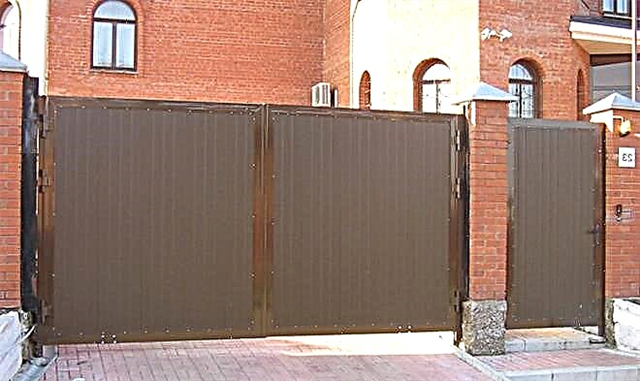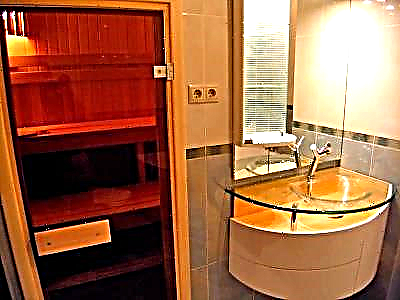
Natural stone has always been valued above other finishing materials. On the market you can find many analogues that accurately convey the color and texture of the stone surface. However, the real stone in the interior looks especially noble, emphasizes the taste and wealth of the owner. Also, this material is especially durable.
The construction market has a fairly large assortment of natural stone. This article is devoted to the most famous and sought-after material - natural slate. In order to use it in the interior, you should know what properties it has.
Features
Slate is often called flagstone. This name appeared due to the characteristics of the origin of the material. Stone is a rock that appears at great depths due to compaction and crystallization of clay.
Slate has a very wide range of colors. It depends on what chemicals were involved in the formation of the rock.
The most common are golden, violet, green, black and brown colors, as well as their various variations (from saturated dark to delicate light shades).
Varieties
Slate is divided into species that differ in composition and origin.
Five types of shale rocks are distinguished by the type of material:
- Chlorite materials. The main distinguishing feature of this slate is the green color with overflows. The main mineral is chlorite.
- Siliceous flagstone. This breed forms sheets, less often slabs of black, purple, red, gray, green. The basis of the material is quartz crystals.
- Mica flagstone. The basis is quartz mica. The most common shades are light gray, brown and black.
- Clay materials. This is the most popular type of slate used for decoration boards. Color is dark gray or black. Formations often look like lumps that are easy to crack.
- Oil shale. This material resembles hardened clay in its properties. It is highly flammable.
The properties
When choosing a material for decoration, it is important to determine what qualities decorative tiles should have.
Natural stone has many advantages, slate is no exception:
- Environmental friendliness. Shale products are of natural origin, they are absolutely safe for human health.
- Increased durability. This is a huge plus of stone. It is able to withstand maximum loads, while maintaining its original appearance.
- Moisture repellent. As you know, rock does not absorb moisture, which means that the dampness of such material is not terrible.
Tiles can be used to finish floors and walls in the bathroom or sauna.

- Resistance to temperature changes. Many materials do not cope with extreme heat and cold, which cannot be said about slate tiles.
- Sound insulation ability.
- UV Resistance. The material copes well enough with exposure to sunlight, does not fade and does not lose a presentable appearance.
- Durability. Natural stone will serve you for many years.
- Ease of installation. You can lay such a tile yourself, without involving specialists in the work.
Application
Limestone is a very popular finishing material. It is used not only for exterior decoration of houses and personal plots, but also for interior decoration of premises.
Landscape designers have long appreciated the convenience and flexibility of the material and actively include it in their projects.

Exterior finish
As a rule, large and thick slate slabs are used for decorating plots, namely for decorating walkways and platforms. This helps to emphasize the proximity to nature. Thin slabs will be a great addition to the design of flower beds or stairs. Pergolas decorated with such material become like ennobled caves.
You can also often see the stone cladding of a house or part thereof. This is just perfect for those who value natural and noble materials.

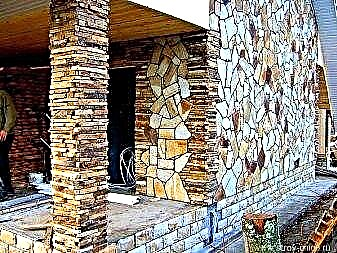
Interior decoration
Slate slabs are also used for interior decoration work. Designers offer many solutions using natural stone. You can cover the entire floor of the living room with such plates, after choosing the desired color.

A black or dark gray shade will look especially impressive. This will add a touch of strict luxury to the interior style.
Very often, the material is used to decorate individual elements. It can be columns or stairs, bar counters or a fireplace. Wall tiles can be an ideal solution for highlighting any zone. In any case, each element made of natural stone will favorably emphasize the style of the room and the individuality of the design.
Cost
Natural stone has always been considered a luxury, and slate is no exception. The material can be attributed to the class of elite finishing options. This fact is a big minus of the slate. However, the high cost fully justifies itself, because numerous advantages outweigh this only drawback.
This applies to the luxurious appearance, and to the reliability of slate tiles. The service life of such a coating exceeds the durability of analogues. If you want your house to go to your children, and possibly grandchildren in their original form, it is worth considering choosing this particular option for its design.
Overview of the slate in the interior in the next video.
About Material
Slate is a rock that formed many millions of years ago - supposedly under the influence of ultra-high temperatures. This is a natural stone with a pronounced layered structure.
Due to the absence of capillaries and pores in the material, it does not pass moisture and does not absorb it, has excellent ezvuko-and heat-insulating qualities, is not afraid of severe frosts and does not deteriorate with a sharp change in the temperature background. Shale coating does not change its characteristics at all under the influence of sunlight. The slate was also recognized for its excellent aesthetic qualities.
Want to know what a house with a sloping roof looks like?
You can read useful information about liquid roof waterproofing here.
Regarding the work with the material, we can say that, despite a fairly high level of strength, it can be easily cut and drilled. All items are manufactured exclusively by hand. The plates are peeled off from the shale block, and then subjected to processing according to a special technology to give the element the desired shape, size and appearance. Slate roofs are durable and have a sufficient degree of elasticity, so as not to be covered by cracks from accidental impacts.
Compared to other roofing materials, slate does not differ in a special richness of shades. Such roofs are mainly gray in color with a characteristic oily graphite sheen. There are slates of brown, bottle-green or burgundy shades: using them, you can lay out the original ornament on the roof. The closest to the slate in color is the polymer roof renoplast - therefore, their successful combinations are possible.
Specifications
The slate tile used for roofing is a piece-shaped tile. Tiles can be of different geometric shapes, which they are given after separating the plates from the general array, mechanically grinding them and processing the edges.
Key parameters for roofing slate:
- Tile sizes: from 20 x 25 to 60 x 30 cm
- Thickness: 4-9 mm
- Weight 1 sq. m - 25 kg. In the case of double laying, the mass reaches 50 kg / sq. m, resulting in special requirements for the crate and rafters.
- The smallest slope of the slope, at which shale is acceptable as a roofing material, is 22 degrees. In the case of a steeper slope, the use of shale tiles of a smaller size is possible.
- Bending strength - more than 6 MPa
Advantages and disadvantages of shale roofing
Some positive qualities of the slate roof have already been mentioned. So, the main advantages of this roofing material:
- Durability.
- Safety for the health of people living in the house.
- Appearance: does not change under the influence of solar ultraviolet radiation and does not lose its original qualities. This property is very important when creating a roof using slate tiles of different colors.
- Due to the strength characteristics of the material, such a roof will not need to be repaired for a long time.
- The small dimensions of the tiles make them the ideal material for creating a roof covering of the most complex shapes - including those with multiple curved lines, dome-shaped, etc.
- The material retains moisture on the surface, does not absorb it and does not swell over time.
- It perfectly adapts to temperature changes, without losing quality characteristics and without changing geometric dimensions.
- Despite the increased strength, the roof is elastic and flexible.
- Slate is processed without much physical effort using special tools.
Of the shortcomings of the material should be noted:
- The lack of a rich color palette. In addition to natural gray, burgundy, brown and dark green shades, there is also a slate with mica impregnations, when using which the roof glistens in the sun. The most popular is the gray version, and the rest are used as decoration fragments.
- Another disadvantage is the significant weight of the material, requiring a reinforced truss system.
- A disadvantage can be considered the price of a slate roof. Currently, a square meter of such a coating costs about 50 to 150 euros.
The final cost is formed under the influence of several factors:
- material quality
- shape and size of tiles
- styling method
- stacker qualifications.
The high cost of the material is largely due to the method of its extraction (work is carried out at a considerable depth) and manual processing.
Preparation for laying slate
 As already mentioned, a significant weight of the material requires the installation of a rafter system in strict accordance with the requirements of SNiP regarding the bearing capacity of the roof frame.
As already mentioned, a significant weight of the material requires the installation of a rafter system in strict accordance with the requirements of SNiP regarding the bearing capacity of the roof frame.
The optimal step size of the rafters is 80 cm. If the step is larger, reinforcement of the lathing is necessary to prevent possible deflection.
The crate, on which the shale roof should be installed, is best made solid based on plywood with a minimum thickness of 20 mm. OSB boards or floor tongue-and-groove boards of 150 mm width can also be used (maximum permissible value).
With a rafter pitch of up to 800 mm, the board should have a thickness of 25 mm. A rafter pitch of up to 1 meter requires the use of boards with a thickness of 30 mm or more.
After the crate is installed on it, a waterproofing membrane is laid. Waterproofing acts as a temporary roof and prevents the penetration of rainfall into the roof space. A template can be applied to the waterproofing material for further unfolding of slate tiles.
Tile Laying Options
Installation of a slate roof is carried out in three popular ways:
The choice of a specific method is determined by the shape of the acquired tiles.
The essence of the English (double) method consists in the use of square, rectangular tiles or elements with a rounded or pointed edge, the fastening of which is carried out using hooks or copper nails. If the slope is less than 40 degrees, two nails are enough to fix each tile. When the angle of inclination is more than 40 degrees, three nails must be used to fasten the elements
In accordance with the English method, laying is carried out in horizontal rows in compliance with the vertical inlet and side gap from 30 to 60 mm, i.e. each even row should be shifted sideways by half a tile with respect to the previous odd row.
The main feature of the English method is that the third row of slate tiles partially overlaps the first in height.
In the French way square tiles with cut side corners are used. Their installation is carried out by sharp angles down and up. For fastening to the crates, nails are used. The joint of the tiles on the roofing ridge is compacted by laying two rows on the leeward side 40-60 cm above the tiles of the second slope. The angle formed in this case is smeared with a strengthening solution.
German styling option is the most unpredictable. Its second name is “wild styling”. It is rooted in ancient times, when the poor living near shale quarries, the poor, covered their roofs with various shale pieces.
If you need the look of a four-sloped hip roof design, take a look here.
You will find many useful tips on soft roof repair technology at https://rooffs.ru/myagkaya/info/tehnologiya-remonta.html
Despite the relative cheapness of the material, the implementation of this method of masonry is more expensive than others, since the craftsmen have to carefully select each plate. The so-called scaly roofing also belongs to German masonry. Today, this is the most popular method, as the largest manufacturers began producing plates in the form of a square with rounded edges, the installation of which can be carried out in almost any direction. Previously, such tiles were produced for the left and right directions of masonry.
Simple laying of slate tiles according to the German technique is carried out in ascending rows. This method involves overlapping the underlying tile below with the observance of the upper and side inlet. The angle at which the tiled rows are placed with respect to the cornice depends on the angle of inclination of the roof slope.
During the laying of slate in accordance with the German method, the tiled rows ascend both to the right and to the left. In this case, the dominant direction of the winds in a particular region should become a determining factor: the roofing material is laid so that the wind does not penetrate the mounted tiles and does not violate the roof tightness.
General rules for installing slate tiles

- Before the installation process on the roof, all tin and carpentry work must be completed, a lightning rod, antenna, and other necessary elements should be implemented. The laying of slate tiles is the last stage of work.
- Prior to laying, the prevailing wind direction is determined. Depending on it, the direction of installation of the slate plates is also chosen, due to which it is possible to achieve maximum waterproofing of the roofing surface.
- To distribute the material in layers, it is necessary to sort the plates in advance according to their thickness.
- Before nailing the plate to the crate, you need to easily tap it with a hammer. At the same time, slate should emit a pure metallic sound. If the sound is dull, the element is considered substandard. Such plates can be cut along the crack line and get two smaller elements: it is recommended to use them at the beginning of a new row or at the end of a completed one.
- The plates are fastened using any stainless nails with a fairly wide head.
- Each plate is fastened using two nails into the holes in it. Three nails are used for fastening the plates, which are under a heavy load, as well as for the installation of extreme elements and in the case of a slope of more than 40 degrees.
- During operation, care must be taken to ensure that the nails do not clog all the way. Between the tile and the nail head, a small distance must certainly be maintained, the presence of which will allow the plates to move freely in case of deformation of the roofing surface. With rigid fixation of the plates as a result of the settlement of the building, they crack.
CONCLUSIONS:
- Slate is a natural stone with a pronounced layered structure.
- With its help, you can arrange a roof of any configuration and complexity.
- Despite the relatively high level of strength, it is easy to cut and drill.
- Slate has a number of advantages, one of which is its exceptional durability.
- Today, there are about 250 types of patterns for the formation of slate tiles.
- Significant weight of the material requires the installation of a rafter system of increased strength.
- The crate is best done solid.
- A waterproofing membrane is laid on the crate.
- Installation of slate roofs is carried out in three popular ways: German, French, English.
For more information on how to make English slate for the roof, see the video.
Application area
Natural slate has fairly high quality indicators, which allows the use of such material in various fields of construction work.
Basically, slate is used for the following purposes:
- As a floor covering in residential and industrial premises.
- External wall cladding.
- Interior wall cladding.
- Decoration of individual elements. Tiles can be used to frame a mirror, washbasin or a small window in the bathroom. To decorate the mirror, it is better to use a tile of dark tones.
- Paving sidewalks.
- Roofing for the roof.
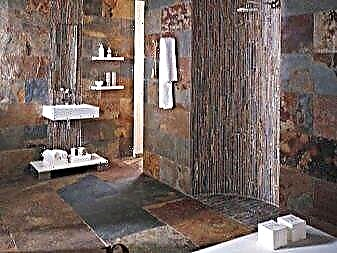

When choosing a shale coating for internal work, you need to consider some characteristics of the material.
What you need to pay attention to:
- Tile size. The width and length of high-quality tiles should not differ by a millimeter. The smallest deviations in size will lead to difficulties in laying the material. In addition, a coating of uneven tiles will look poor and unattractive.
- The thickness of the tiles should not vary significantly. If the products in the batch have obvious differences in thickness, this indicates a poor quality of the material. As a result of installation, you will get an uneven surface.
- Colour. Slate tiles have a non-uniform color. In one batch, products may vary in shades. It is important that this difference is not too significant.

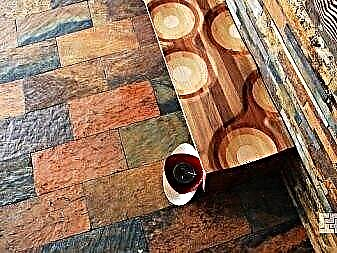
Styling recommendations
Before proceeding with the decoration of the floor or walls, it is necessary to prepare the surface - clean it well from dirt, repair cracks and smooth it out. Cracks and irregularities are repaired with plaster or putty. Then the surface must be sanded.
For sanding, you can use sandpaper or a grout to grout putty.


As a tool for cutting tiles, you can use a circular saw on stone. Finishing material is attached to the surface using high-strength tile adhesive. If the tile is used for flooring, then as a bonding composition it is better to use rubber-bitumen mastic.
After the adhesive has completely dried, the joints must be filled with tile grout. When finishing a damp room (for example, a bathroom), you can additionally fill the joints with sealant.
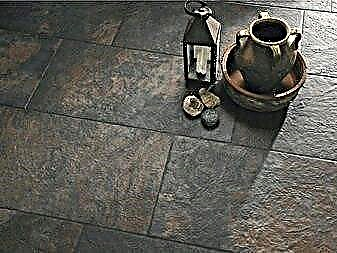
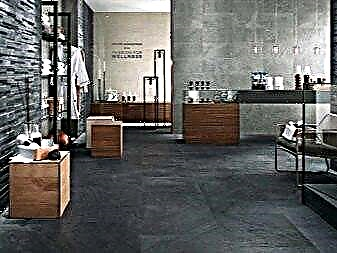
About how to use slate in the interior, see the next video.

